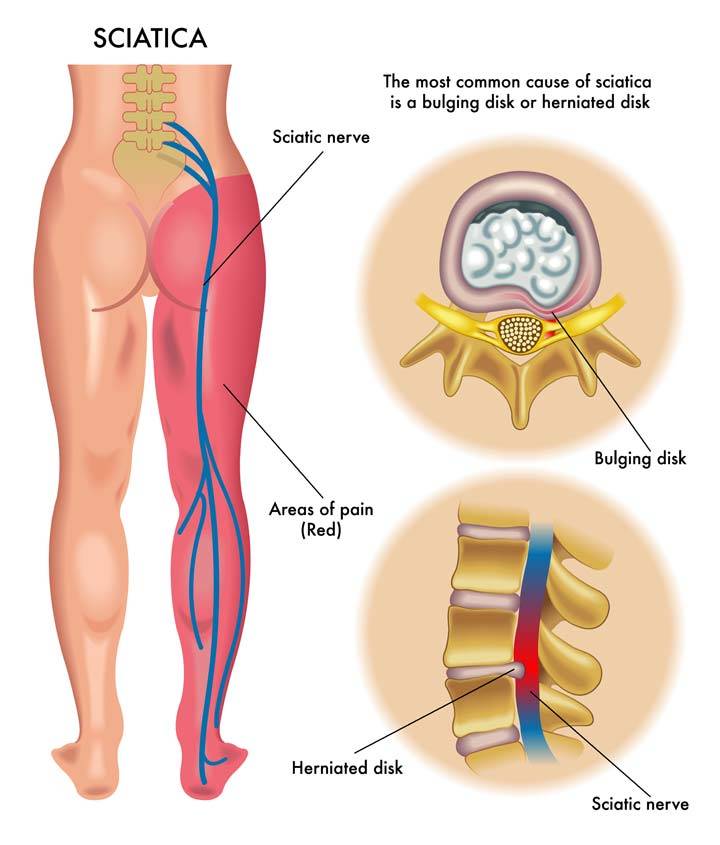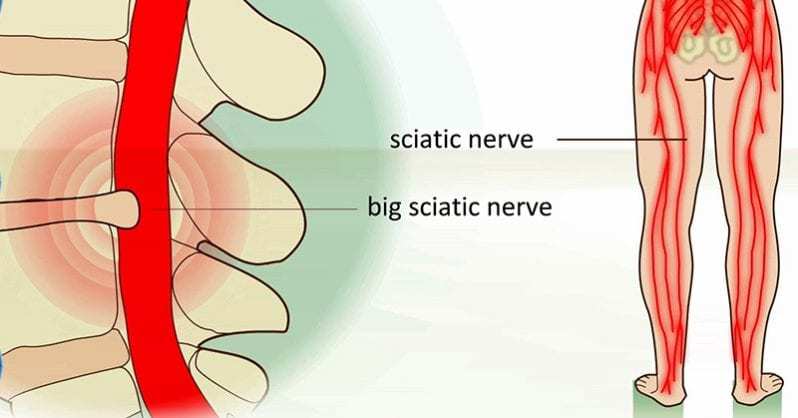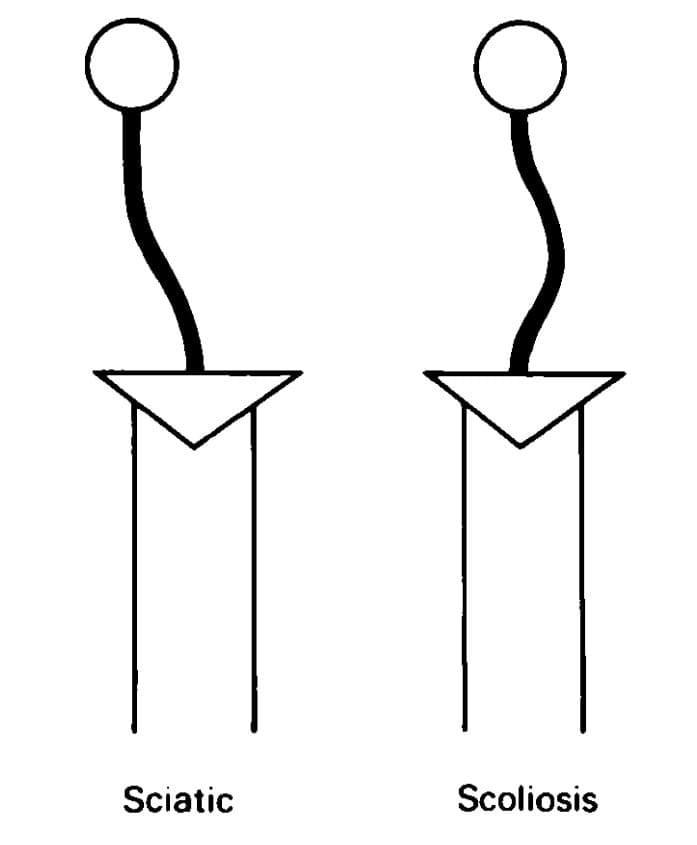Sciatica Treatment London, UK
Are you tired of living with the constant pain and discomfort of sciatica?
Discover the proven rehabilitation techniques that can help you find lasting relief in our comprehensive guide.
Dealing with sciatica pain is one of the most disabling symptoms that hold you back.
Unfortunately, when you get moving your sciatica pain gets worse.
So, you assume it is safer, and less painful to stay still.
And you end up not even going to the rehab centre!
Sorry, but that’s WRONG!
If you want the pins and needles gone forever, you’ve to start your laser sharp customised Pilates for sciatica programme ASAP!
No doubt that travelling to and back from the rehab centre might be the worst part of the whole story.
This is why Jazz Alessi offers you a very comprehensive and professional sciatica treatment online.
You can save the time and effort and start your rehab journey right from home.
With our expert sciatica nerve specialist who will assess you online on a video call in order to design a holistic plan that helps you meet all your goals.
During the assessment session, Jazz Alessi will manage to tell if your sciatica pain is due to a bulged disc in your back, a tight piriformis muscle, gluteal spasm or any of many other reasons that may be causing your pain.
It is important for him to decide in order to set you the exact plan to tackle your problem.
After that, you will follow a successful programme of sciatic nerve rehabilitation online composed of one-to-one sessions scheduled to fit in your daily routine.
Learn now how Hayley, Jan, Dr Christian, Michaela, Huw, Elizabeth Tiffany , WT Police officer, M Taylor and Franco successfully rehabbed their sciatica, back injuries and beat their back pain.
After a full rehab period you will see that you are:
- Significantly more active and pain-free
- More flexible
- Having stronger muscles throughout all your body and a tighter core
- Having a better posture
- More balanced
- Less liable to develop recurrent sciatica pain
- Less or no anxiety, sciatica pain poor mood or back pain related depression
- No longer a candidate for surgery
If you are ready to ace the pain with our elite specialist in online sciatica treatment in London, book your FREE CONSULTATION now and discuss your rehab state with Jazz Alessi as a first step towards pain-free leg!
Due to Corona virus contamination risks using selected technology we are able to provide you with a full customised service online catering for all your sciatica injury rehabilitation exercise and nutrition needs.
What are your main targets and goals?
Contact us now through this link.
Consult London’s #1 Sciatica Nerve Specialist- Jazz Alessi
- Do you have any pain shooting down on one, or both legs?
- Do you suffer from sciatica pain?
- Do you have a herniated disc?
- Do you experience lower back pain – burning sensation, weakness or tingling down the leg pain?
- Are you looking for the best Sciatica Treatment in London?
If you experience any sciatica symptoms and pain, keep reading on – we created this professional page to help you.
We are experts in pilates for sciatica, and lower back pain rehabilitation.
We will show what caused your herniated disc and/or sciatica, what type of injury is yours and more importantly…
Throughout this page we will show you how, you can get rid of your sciatica pain!
“My sciatica pain disapeared and I don’t feel stressed anymore. I am sleeping better and I perform better in a very demanding job. Jazz Alessi’s area of specialisation completely covers back pain rehabilitation, and healthy weight loss.”
– Dr Christian H – NHS

Have you been struggling with pins and needles down your leg?
I completely understand your sciatica back pain, and if I were in your place, I would have also been looking for sciatica specialist near me not only to seek professional help, but also to ensure that the sciatica treatment near me does not require too much travel time.
Because let’s face it, once you have back pain with sciatica, it is really hard to stay still, sit in a car or take the tube to far places.
But, isn’t it time to put limit to all the pain and numbness?
As a personal trainer specialised in back, herniated disc and sciatica pain rehabilitation, I will answer some of the most common questions lingering among those suffering from sciatica pain. But, if you have a question that remained unanswered, feel free to request a free consultation now!

Sciatica: Knowing the nerve behind the pain!
Sciatica pain is accompanied by leg pain is a familiar symptom for most of us.
And yes!
It is a symptom, not a condition.
The above 40 population is more affected by sciatica pain. (3)
In London itself, around 1-5% of people have an episode of sciatica every year. 12 Around 10,000 adults undergo elective spinal surgeries in England per year for relief from chronic back pain and sciatica. 7 The lifetime incidence of this condition is estimated to be between 13% and 40%.12 Pressure over your sciatic nerve or its feeder nerve roots anywhere along its course from the spine to the foot gives rise to the characteristic referred pain in the leg. Did you know that if in your case the spinal disc is implicated, L5 and S1 nerve roots that go on to form the sciatic nerve are more affected? The sciatica pain can occur in one or both legs. Each one of your sciatic nerve is formed by the joining of 5 spinals nerves (L4-L5-S1-S2-S3). The spinal nerves exit the vertebral column through the gaps on the sides of the vertebrae (intervertebral foramen), to form a lumbo sacral plexus (bundle of nerves). Branches of this plexus unite to form the thickest nerve, which then emerges through the sciatic notch (an opening in the pelvis). The sciatic nerve passes through (in 15% people) (8) or under the piriformis muscle that is present in the buttock and runs along the back of the thigh. Just at the outer side of the leg it splits into two nerves that run along the side and back of the leg. These nerves supply the muscles in the leg and foot. 16 “Before training I was in some sort of pain 80-100% of the day, which would constantly fluctuate anywhere in between 4-10 on a scale of 10. I was taking anti-inflammatories and pain relief medication almost every day, just to get through and I would have to lay down 7-10 times a day. At work or in social situations I was constantly putting on a brave face, when inside, I was very unhappy, which made me feel isolated and alone. After 6 months of low sciatica pain, I was in quite a dark place emotionally and I knew I needed someone with specialist knowledge about spine injuries, who I could train with one-to-one. I searched online ‘treatment for sciatica uk’ and I found Jazz, and he came and trained me at my location in London. Since completing my rehabilitation with Jazz, my sciatica has completely gone, my back has stabilised and I only feel some discomfort for 5-10% of the day, but this is fleeting as well. I no longer take any medication and that feels wonderful.” – Hayley Ball – Contact Jazz now for a commitment free consultation today by clicking on this link HERE. Pain due to compression of the sciatic nerve or one of its feeder nerves is typical and easy to diagnose. You may have this condition if you have 3 more of the following symptoms of sciatica pain (1): “I used to have sciatica back pain but, thanks to Jazz Alessi’s strengthening and stretching back exercises, customised stretching’s, postural exercises he designed for me I don’t have any spine or back pain anymore. I’m able now to have a very intense workout and I took my fitness to the next level. My back pain disappeared and, I’m feeling great all the time.” – W. T. – London Metropolitan Police – Police Officer Keen to improve your back injury health and get rid of sciatica pain?
Do you have any symptoms of sciatica pain?
Pain down both the legs? Can it be sciatica
In 9 out of 10 cases of sciatica, symptoms are confined to one leg.
Unilateral sciatica is a characteristic symptom of posterolateral disc herniation.
The soft gel like disc pushes out sideways through a rent in the tough outer casing or the annulus fibrosis.
As it pushes out, it compresses the nearest nerve, usually the fifth lumbar or the first sacral nerve root.
- A large central disc herniation can cause bilateral sciatica.
The disc may compress the nerve roots of both sides resulting in bilateral sciatica pain.
- Bilateral foraminal stenosis is a less common cause of bilateral sciatica. The spinal nerves exit the spinal column on each side through openings between the vertebra.
Wear and tear (osteophytes) may narrow these openings and impinge on the nerve roots.

- Bilateral piriformis syndrome may also cause symptoms in both legs.
As the nerve may pass through the muscle in around 15% of the individuals, bilateral tightness of piriformis muscle can compress the nerve causing sciatica. (8,9)
As Jazz Alessi, the most sought after elite personal trainer in Central London and back injury rehabilitation specialist puts it – “Once you professionally assess and know the problem, managing sciatica becomes much easier!”
Keen to improve your back injury health and get rid of your sciatica pain?
Contact Jazz now for a commitment free consultation by clicking on this link HERE.
Is your Sciatica lower back pain stopping you from living?
Some cases of lower back pain and sciatica are self-limiting and resolve within 6-8 weeks2.
However, some people may find the tingling and pain in the legs to be persistent.
The unpredictable nature of the leg pain brings life to a standstill.
- Every little activity like playing with the kids or kicking the football seem daunting.
And if the pain starts as soon as you get up, going through the day becomes an ordeal in itself.
- Sex and intimacy are worse affected as turning in bed or assuming certain positions can kick off the sciatica pain.
- The sciatica pain affects work life too.
- Constantly having to change positions at work disturbs concentration.
- Having to lean against the wall makes you look lazy at the workplace.
This leads to reduced performance.
The sciatica pain can even cost you your job especially if it involves driving, lifting etc, and as you can see below it can have dramatic effects on your income, and increase in anxiety, depression and disability.
Anxiety and depression set in when the pain has been there for too long, lowering the quality of life. 15
Latest research shows that an increased exposure to sciatica risk factors will lead to an increase in sciatica pain effects.
“I had 20, one to one sciatica rehabilitation personal training sessions with Jazz Alessi. During this time, my posture improved tremendously, all of my chronic back pain and back problems disappeared.”
– M. Taylor – Lawyer
Jazz Alezzi, elite personal trainer and sciatica nerve specialist in Central London is skilled in improving even the most stubborn cases.
Know what’s causing your Sciatica pain
Sciatica is a common symptom of several different medical conditions; however, an estimated 90 percent of cases are due to a herniated (slipped) disk.
Sciatica lower back pain can be caused by any of the following conditions:
- Lumbar spinal stenosis –Narrowing of this passage due to wear and tear
- Foraminal stenosis: nerve impingement due to osteophytes
- Spondylolisthesis – When one vertebra slips forward on the lower vertebra which narrows the canal
- Space occupying lesions within the spine – Tumors may reduce the size of the spinal canal, affecting neural mobility
- Infection – Spinal infections can cause swelling that may reduce the size of the spinal canal ultimately compressing the nerves.
- Trauma: Injury may cause sprain of interspinous ligaments (the short ligaments that run between two vertebrae) or a vertebral compression, resulting in lower back pain accompanied with sciatica like symptoms.
Fracture of the pelvis may also injure the sciatic nerve.
- Cauda equina syndrome: a rare but serious condition that affects the nerves in the lower part of the spinal cord; it requires immediate medical attention.
- Sacroiliac joint dysfunction: Malalignment or sprain of ligaments supporting the joint at the base of spine.
- Piriformis Syndrome: Tight piriformis can affect the mobility of sciatic nerve resulting in the sharp pain.
- Chronic hamstring tendinopathy may cause the sciatica pain.
This happens if the scar tissue of the damaged hamstrings tendon entraps and irritates the sciatic nerve.
- Smoking and increased weight have known to aggravate the sciatica pain12
How is Sciatica Diagnosed?
If you live in London, sciatica is diagnosed with a medical history and physical exam by a sciatica treatment near me specialist.
Radiological investigations such as X-Ray, CT scan and MRI help to narrow down the causes of sciatica pain.
X-rays pick up arthritic changes in the facet and foramina that could be compressing the spinal nerves.
CT scan, Magnetic resonance imaging, Discography or Myelography help to identify the level of disc prolapse.
The contrast imaging techniques can also help to identify the neural compression throughout the course of the nerve.
Electrodiagnostic tests like nerve conduction velocity (NCV) or Electromyograph (EMG) determine the extent of nerve and muscle damage respectively to arrive at a prognosis.
Bone scans are recommended if spinal tumor is suspected.
Similarly, blood tests help to identify any infection in the body.
The Difference In Between Muscle Spasm and Sciatica
As you can see below muscle spasms will pull your whole body structure out of balance whilst scoliosis still keeps your trunk centered.
An experienced MD specialised in sports injuries will be able to distinguish in between such effects.

TRUNK POSITIONING ASSESSMENT: muscle spasms trunk displayed (left) vs a structural scoliosis (right) displaying a compensatory curve both above and below whilst the upper body is still centred on the pelvis.
Correlating the clinical findings with the results of imaging studies helps to chart a more effective treatment and sciatica rehabilitation plan.
“Jazz made all the difference I needed and I’m so happy now that my back pain is completely gone. My posture and my core are so much stronger now. Alessi Jazz was born to train and he is 100% focused at all times.”
– Emma Choli – International marathon runner
Contact Jazz now for a commitment free consultation today by clicking on this link HERE.
Troubled by sciatica – Is surgery the solution?
Discectomy or micro-discectomy surgeries relieve sciatica pain by removing or part or whole of the disc.
If disc prolapse is accompanied by degenerative changes in the vertebrae Laminectomy with discectomy becomes the procedure of choice.
Multiple level disc prolapse is managed by removal of the discs and fusion of the segments.
How effective is the surgery in the long run?
The jury is still not out on this one.
Individuals with longstanding sciatica pain prefer to undergo surgery to remove the disc and “get done with it”.
On a short term follow up, pain decreases in 95% of the cases.
Surgery has not proved effective in around 20% of the cases with low back pain and sciatica.5
There may be complications 5,4 like:
- Surgical complications like dural tears (sheath covering the nerve)
- Recurrence of disc herniation at other levels
- Residual or persistent leg or back pain
- Scarring and nerve entrapment
- Infections
- Stiffness
- Foot drop
- Reduced spinal mobility
However, surgery may be beneficial in relieving sciatica pain due to stenosis or advanced grades of spondylolisthesis.17
Thus, a complete physical assessment and systematic elimination of other causes must be done before selecting a patient for surgery.
- Non-surgical management of sciatica pain includes use of painkillers, muscle relaxants, rest and physical therapy.13
- Physical therapy: among other things, physical therapy targets at improving nerve muscle flexibility, strength and core strength.
- Spinal mobilisation and deep tissue manipulation are used as powerful adjuncts to exercise therapy for relieving pain.
- TENS (transcutaneous electrical stimulation – electric shocks via the skin) may be used to relive chronic sciatica pain.
- Chiropractic (realigning the bones and joints) may be useful in relieving sciatica pain due to facet or SI joint dysfunction.
- Acupuncture has been experimented by many patients to relieve chronic low back and sciatica pain whilst in some people it just doesn’t work.
- Steroid injections: the long-term efficacy of steroid injections to relieve pain is still debatable though it provides instant relief in acute cases. (12)
- Cognitive behavioural therapy and modification of activity are other effective adjuncts to physical therapy.
A trusted name in Central London’s elite circles for the management of lower back and sciatica pain, Jazz Alezzi a Pilates expert, stresses on customised exercises for the management of this condition.
Managing Sciatica pain through Pilates exercises
Specific exercises have proven to be effective in the long-term management of sciatic nerve pain.
These Pilates for sciatica exercises concentrate on bespoke core strengthening, increasing flexibility, and joints, muscle balance, coordination, controlled movement, breathing, strength, hamstring and piriformis stretching and a customised aerobic exercise. (13)
We start proceeding with a:
- Thorough one to one consultation,
- Advanced video assessment then,
- We customise everything starting your individualised and effective sciatica rehabilitation programme.
Collectively, this evidence based approach will make a significant difference in your case relieving the sciatic nerve pain sometimes even, in proportion of over 95%.
Jazz Alezzi, a top notch elite personal trainer Pilates and sciatica specialist in Central London, helps you relieving the sciatica pain through measured combination of customised exercises.
Core strengthening plays a key role in relieving sciatica pain due to a herniated disc or spinal arthritis.
We test your short multifidus and the transversus abdominis strength.
We design exercises to prevent excessive motion at the involved spinal segment.
This reduces the strain on the discs and surrounding ligaments which ultimately reduces your sciatica pain.
Core strengthening or lumbar stabilisation exercises help to maintain the normal lumbar lordosis while performing bending and lifting movements.
Improved strength in these muscles, helps to distribute the increased loads on the spine during these movements, preventing the onset of pain.
Hamstring and piriformis stretching is an integral part of managing sciatica in both discogenic and non discogenic causes of sciatica nerve pain.
As the sciatic nerve passes deep to the hamstring muscle, its tightness affects neural mobility.
Achieving flexibility in these muscles ensures unrestricted neural movement and lasting relief from sciatica.
However,
- The wrong way of stretching your muscles will immediately make your sciatica to flare up and set back your recovery for weeks and sometimes months.
Aerobic exercises have a special contribution in relieving nerve related pain but, they are not equal and some exercises will cause sciatic pain and a flare up.
It has been proved that aerobic exercises release ‘happy hormones’ or the endorphins that help to combat the depressing effects of serotonin.
They are body’s natural morphine like pain killers that interfere with the pain perception in the brain.
As a result, individuals enjoy a sense of euphoria and well-being, helping them to manage the pain better.
- When comes to aerobic exercises the key point is, individualisation.
I train you to get there safely by, reducing and eliminating flare up risks.

“I wanted to improve my fitness level, gain more energy and lose weight while, correcting my posture and getting rid of my severe back pain. Once we start training Alessi was always available and answered all the questions and back rehabilitation queries I had. I achieved everything I wanted and I went beyond my goals. My posture is so much stronger and I don`t feel any back pain anymore.”
– Alless – Fashion designer
Contact Jazz now for a commitment free consultation today by clicking on this link HERE.
Why Customised Sciatica Rehab program is a must!
Your injury, compensatory mechanisms within your movement patterns, muscles strength and weakness, stress levels and injury recovery fears are different from anyone else.
This why any rehabilitation programme for the management of sciatica pain must be 100% tailored to your specific needs.
A sciatic nerve pain can arise from a variety of causes that can be diagnosed by only the most experienced clinician.
Choosing to go for a generalised set of exercises without looking at the cause can be disastrous in so many ways!
Sciatica due to disc herniation needs to be managed with customised exercises, and in many cases more flexion or back extension exercises will only damage the disc more.
Adding a one to one core strengthening (Pilates) will help to maintain the spine in neutral as you go through your chores at home or work.
Vigorous or over stretching of the tight hamstrings or piriformis muscle may only irritate the nerve more, increase muscle spasm and cause a flare up.
Understanding the intensity of stretch from an experienced injury rehabilitation expert and elite personal trainer is always crucial to keeping you progressing safe and avoid flares up.
- Sciatic pain associated with a facet joint arthritis or foraminal stenosis will benefit from forward bending exercises.
- Doing the back ward bending exercises will cause further nerve root impingement and exaggeration of symptoms.
- Sciatica resulting from listhesis will never be relieved from the extension exercises used in disc herniation.
The listhesis will only get worse.
Flexion and lumbar stabilisation exercises work in some situations but, don’t work in others.
Strengthening of the core and back extensor muscle though advantageous needs to be performed in a very careful and progressive manner to avoid muscle overuse and fatigue, and sciatica flare ups.
Pain arising from Sacroiliac dysfunction is not relieved by hamstring stretching.
Improving mobility around the Sacroiliac joint and focusing on stabilisation exercises in some cases will be more effective while in others won’t work.
Sciatica Pain Rehabilitation Programme by Jazz Alessi, Pilates Expert
Every type of job or profession places demands on your body, especially on your spine.
I have seen more than 200 back pain and sciatica clients over the last 20 years.
Alongside mine or your sports medical doctor, London physiotherapist or on my own (you chose).
I will complete and deliver to your satisfaction:
- A comprehensive one to one consultation,
- Advanced video assessment, and I will
- Design an effective and customised back injury rehabilitation programme managing the dreaded sciatica pain – this is fully tailored to your specific goals and needs.
- Return to optimum activities and a high level of fitness
- Transformed confidence,
- Improved mood and happiness levels
- Lose weight naturally if you will want too
- Coaching you throughout with direct access to call me anytime you will want (social hours)
- Teaching you how to address your sciatica and back pain yourself so, it is sustainable (and cheaper) over the long term.
Having successful rehabilitated the most stubborn cases of sciatica across Central London, I understand the importance of crafting a unique and individualised Sciatica rehabilitation programme.
My specially blended one to one exercise routine helps you fight the pain and face the challenges of your profession.
As a rehabilitation expert and an elite personal trainer in London putting together a set of impactful sciatica and Pilates exercises that work just for you, is an art I have developed.
My rehabilitation programme is scientific and evidence based.
After conducting a thorough hands on physical and biomechanical assessment, and advanced video assessment I create a step wise plan to minimise pain and restore function as quickly as possible.
I am also a 2nd generation Pilates instructor in Central London – we are under 20 people trained at this level in the whole UK.
I am a long term certified nutritionist, Yoga movement assessment specialist and a Martial Arts teacher.
My sciatica and Pilates rehabilitation programme is 100% customised and effective for your rehabilitation needs but, to keep things fresh and entertain you I can use hundreds of modified exercises (so, they will be safe) derived from the methods of exercise forms I mentioned.
I always interact and work closely with you and your healthcare team (physios, doctors) to avoid surgery for sciatica.
And if you have had one, I will work with you to get back to work as early as possible.
“What Jazz does is prepare a customised personal training programme, for you as an individual. The customised exercises Jazz designed for me helped me not just to completely get rid of my back pains, but, also the tension I’ve had in my shoulders, and hip pain and overall it increased my body coordination, flexibility and the range of movement throughout my body. Jazz personal style has always been uplifting, positive and compassionate. I’m also about two stone lighter now than I was when we first met and I think that this is another major health plus.”
– Beverley Sage – ex singer – Artist
If you are are in pain and looking for a sciatic nerve specialist near me or a long term sciatica pain rehabilitation London expert you can contact me at any time, and any place – just hurry as I can only train a limited number of clients.
- Depending on the level of back pain, spinal and herniated disc damage the clients usually require a number of 12, 18 or 28 sessions of customised sciatica pain rehabilitation.
All I need is a Pilates mat, and I will bring into your house my customised and very effective sciatica rehabilitation method to help you rehabilitate your sciatica, and low back pain!
Keen to improve your back injury health and get rid of sciatica pain?
Contact Jazz now for a commitment free consultation today by clicking on this link HERE.
FAQs
Can rehabilitation help sciatica?
Customised rehabilitation (customised is the keyword here) can help you positively transform, get rid of your sciatica not only temporarily, but also permanently if done in the right way and based on thorough and dedicated sciatica injury assessment to determine the cause of your sciatica.
How do you rehabilitate sciatic nerve?
Sciatica rehabilitation programmes vary based on the cause and site at which the sciatic nerve is pinched. It can harness a combination of body posture training, strengthening, specialised movements, stretching and flexibility exercises in addition to nerve flossing and nerve mobility exercises.
What is the fastest way to heal sciatica?
The fastest way to heal sciatica is by following a customised rehabilitation programme from the first shot instead of putting time and effort into several wrong generalised sciatica rehab programmes. The right rehab programme will be based on professional assessment of your very personal symptoms and problems followed by a laser-sharp customised plan to successfully conquer your symptoms.
What are the top 3 exercises for sciatica?
There is a countless number of exercises that are great in treating sciatica pain. However, these exercises mainly fall into one of three categories (i.e., stretching, strengthening and nerve flossing) but not limited too – sciatica rehab customisations are always your best bet.
Contact Jazz now for a commitment free consultation today by clicking on this link HERE.
References:
- Proceedings of the Royal Society of Medicine Vol. XXXV page 37 505 JOINT DISCUSSION No. 4 Sections of Neurology and Orthopaedics Chairman-GEORGE RIDDOCH, M.D.(President of the Section of Neurology.)[January 17, 1942]”Discussion on sciatic pain”
- https://www.physio-pedia.com/Sciatica
- https://www.webmd.com/depression/guide/exercise-depression#1
- http://www.orthospine.com/index.php/index.php?option=com_content&view=article&id=69&Itemid=27
- Mahsa Sedighi and Ali Haghnegahdar “ Lumbar Disk Herniation Surgery: Outcome and Predictors” Global Spine J. 2014 Dec; 4(4): 233–244.
- https://www.england.nhs.uk/blog/charles-greenough/
- Cass SP, “Piriformis syndrome: a cause of nondiscogenic sciatica.” Curr Sports Med Rep. 2015 Jan;14(1):41-4.
- Lijec Vjesn. “Piriformis muscle syndrome: etiology, pathogenesis, clinical manifestations, diagnosis, differential diagnosis and therapy” 2013 Jan-Feb;135(1-2):33-40. https://www.ncbi.nlm.nih.gov/pubmed/23607175
- https://www.laserspineinstitute.com/back_problems/back_surgery/complications/
- Machado GC1, Witzleb AJ2, Fritsch C3, Maher CG2, Ferreira PH4, Ferreira ML2,5. “Patients with sciatica still experience pain and disability 5 years after surgery: A systematic review with meta-analysis of cohort studies” Eur J Pain. 2016 Nov;20(10):1700-1709. doi: 10.1002/ejp.893. Epub 2016 May 12. https://www.ncbi.nlm.nih.gov/pubmed/27172245
- Peul WC1, van Houwelingen HC, van den Hout WB, Brand R, Eekhof JA, Tans JT, Thomeer RT, Koes BW; Leiden-The Hague Spine Intervention Prognostic Study Group. “Surgery versus prolonged conservative treatment for sciatica.” N Engl J Med. 2007 May 31;356(22):2245-56. https://www.ncbi.nlm.nih.gov/pubmed/17538084
- M. A. Stafford P. Peng D. A. Hill “Sciatica: a review of history, epidemiology, pathogenesis, and the role of epidural steroid injection in management”BJA: British Journal of Anaesthesia, Volume 99, Issue 4, 1 October 2007, Pages 461–473, https://doi.org/10.1093/bja/aem238 . https://academic.oup.com/bja/article/99/4/461/305514
- https://www.nice.org.uk/guidance/ng59/resources/low-back-pain-and-sciatica-in-over-16s-assessment-and-management-pdf-1837521693637
- Verwoerd AJ1, Luijsterburg PA2, Koes BW3, el Barzouhi A4, Verhagen AP, “Does Kinesiophobia Modify the Effects of Physical Therapy on Outcomes in Patients With Sciatica in Primary Care? Subgroup Analysis From a Randomized Controlled Trial” Phys Ther. 2015 Sep;95(9):1217-23.
- Hider SL1, Whitehurst DG, Thomas E, Foster NE, “Pain location matters: the impact of leg pain on health care use, work disability and quality of life in patients with low back pain” Eur Spine J. 2015 Mar;24(3):444-51.
- https://www.magonlinelibrary.com/doi/abs/10.12968/hmed.2016.77.11.C180
- Fernandez M1, Ferreira ML2,3, Refshauge KM4, Hartvigsen J5,6, Silva IR4, Maher CG2, Koes BW7, Ferreira PH, “Surgery or physical activity in the management of sciatica: a systematic review and meta-analysis.” Eur Spine J. 2016 Nov;25(11):3495-3512. Epub 2015 Jul 26.


